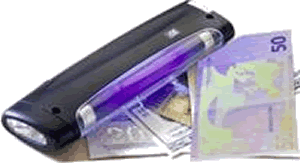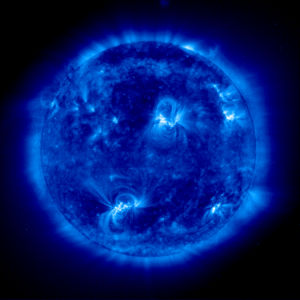Uses of ultra-violet radiation
Security marking
 A UV watermark is included on many sensitive documents (e.g. credit cards, driver's licenses, passports) to help prevent fraud.
A UV watermark is included on many sensitive documents (e.g. credit cards, driver's licenses, passports) to help prevent fraud.
The watermark can only be seen when viewed under a UV-emitting light source. Currencies of various countries' banknotes have an image, as well as many multicolored fibres, that are visible only under ultraviolet light to thwart couterfeiters.
The inks absorb invisible UV (or 'black light') and then emit visible light which can be seen by the human eye.
 Astronomy
Astronomy
Very hot objects emit UV radiation.
Because the ozone layer blocks many UV frequencies from reaching telescopes on the surface of the Earth, most UV observations are made from satellites orbiting above the atmosphere.
The image on the right is of our Sun's corona - taken in the UV.
Biological surveys and pest control
Some animals, including birds, reptiles, and insects such as bees, can see into the near ultraviolet. Many fruits, flowers, and seeds stand out more strongly from the background in ultraviolet wavelengths as compared to human color vision, insects such as moths and butterflies often have markings that we cannot see because they reflect ultra-violet not visible light. Scorpions glow or take on a yellow to green color under UV illumination. Many birds have patterns in their plumage that are invisible at usual wavelengths but observable in ultraviolet, and the urine and other secretions of some animals, including dogs, cats, and human beings, is much easier to spot with ultraviolet.
Many insects use the ultraviolet emissions as a reference for flight navigation. A local ultraviolet emission will normally disrupt the navigation process.
Ultraviolet traps are used to kill some small flying insects. They are attracted to the UV light, and are killed using an electric shock, or trapped once they come into contact with the device. Different designs of ultraviolet light traps are also used by entomologists for collecting nocturnal insects.



 A UV watermark is included on many sensitive documents (e.g. credit cards, driver's licenses, passports) to help prevent fraud.
A UV watermark is included on many sensitive documents (e.g. credit cards, driver's licenses, passports) to help prevent fraud.  Astronomy
Astronomy



